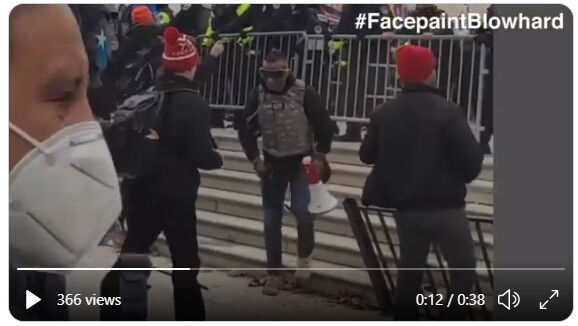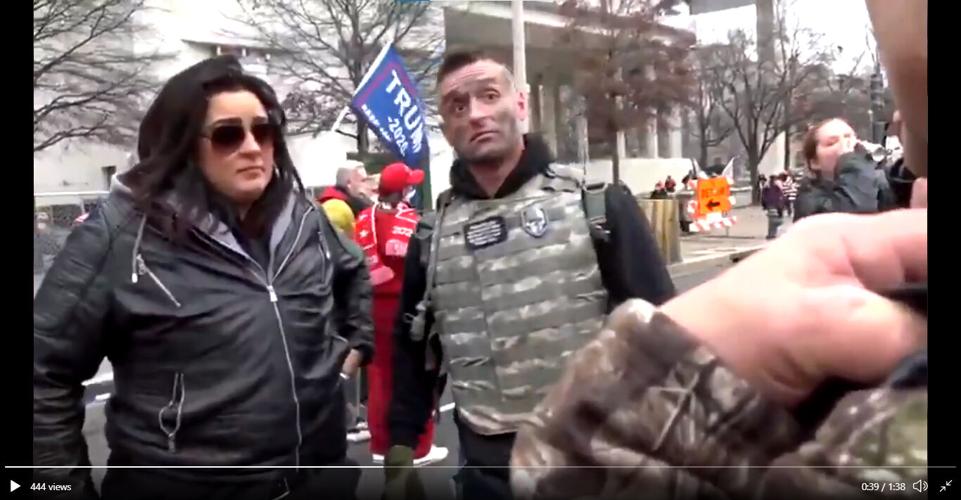Samuel Lazar, the Ephrata man who pepper-sprayed police and encouraged violence during the riot outside the Capitol on Jan. 6, provided federal prosecutors with valuable information about other Jan. 6 defendants, according to federal prosecutors.
Lazar, 38, also agreed to testify in a murder trial and gave the government information about drugs and weapons smuggled into a federal detention facility.
The “substantial assistance” warranted a sentence below what federal sentencing guidelines would have called for, according to court documents.
Lazar pleaded guilty March 8 to assaulting or resisting a federal officer, and on March 17 he was sentenced to 30 months in prison. He faced a maximum sentence of 20 years, though guidelines called for a range of 51 to 63 months, according to the government.
Lazar was released from prison on July 18 to a halfway house, then freed from federal custody on Sept. 13.
The documents had been sealed but were unsealed for a brief time this week after a federal judge ordered them unsealed upon the mistaken belief that the government and Lazar’s attorney had not filed a proposed redacted version. After the attorneys showed the court that they had submitted their version in November, the mistakenly unsealed documents were removed from the official online court docketing system.
However, media outlets, including NBC News and LNP | LancasterOnline, were able to obtain the filings through a third-party website that automatically collects and indexes government court filings.
Lazar’s attorney Hope Lefeber and a spokesperson for the U.S. Department of Justice said they had no comment on the mistakenly unsealed documents.
NBC News reporter Ryan Reilly reported details from the documents Wednesday. In March, Reilly ran into Lazar’s family members in the federal courthouse in Washington and reported that Lazar was to be sentenced — a fact that was shielded from the public for months, prompting a coalition of media organizations to file legal briefs objecting to the secrecy around Lazar’s case.
Revelations in documents
According to the sentencing memorandums filed by the government and Lazar’s attorney, Lazar was willing to testify for the government about a defendant in a murder trial, although ultimately, the government did not call him as a witness.
Lazar also “gave the government valuable information with respect to other Jan. 6 defendants,” federal prosecutors wrote. The exact details of Lazar’s cooperation and names of the other defendants were not disclosed.
Prosecutors wrote that in addition to his cooperation, Lazar “has also shown substantial remorse for his behavior and describes himself as a man who is ashamed of his conduct in a genuine, credible manner.”
Lazar’s attorney wrote in her pre-sentencing memorandum that Lazar’s crime, “his actions and his words stand in stark contrast to the person that he truly is and the life that he led prior to that fateful day depict a god-fearing man of high integrity, who loves his country and has the utmost respect and admiration for law enforcement. The son of immigrant parents from Romania, he feels honored and blessed to live in this country. Sam is a quiet family man who is kind-hearted and compassionate to his fellow persons.”
Video footage shows Lazar spraying police with a chemical irritant, taunting them and urging others to “take their guns.”
Lazar’s attorney wrote that Lazar’s words and actions “are the antithesis of who he is” and, to the contrary, he has a deep respect for law enforcement.
The memorandum described Lazar buying pizza for Lancaster city police in September 2020 following protests related to the police shooting of a man in Lancaster. Lazar, carrying a half-dozen pizzas to Lancaster city police station, led several people with him in chants of “back the blue.”
“This was Sam’s way of boosting morale and showing the police officers that their work was valued,” the memorandum said.
Lefeber wrote Lazar “did not arrive at the Capitol on Jan. 6 with the intention to engage in any form of violence. He came with his sister and a female friend of his sister and met up with his brother and two friends. He brought no weapons or any instruments of crime. The only thing he brought was his bullhorn which he had brought to previous political rallies to play both patriotic and Christian music.”
Lazar can be seen in videos from Dec. 5, 2020, using the bullhorn to lead protest chants outside the Drumore Township home of state Rep. Bryan Cutler. At the time, Cutler was speaker of the Pennsylvania House, and Trump supporters like Lazar believed, incorrectly, that the Legislature could intervene to strip the state’s electoral votes from Joe Biden.
The same gathering outside Cutler’s home is notable for the presence of two other people arrested for crimes related to Jan. 6: Sandy Weyer, of Mechanicsburg, and Lynn Nester, of Dillsburg, who were charged with illegally entering the U.S. Capitol that day, also attended the Cutler protest that day and returned nearly a month later on Jan. 3, 2021.
Hashtag nickname
LNP | LancasterOnline was the first news organization to identify Lazar as a person pictured in the FBI’s Capitol attack photo gallery. The newspaper ran its story on April 11, 2021. Lazar’s arrest came three months later, on July 26, 2021. In the time between LNP’s story and his arrest, Lazar attended a fundraiser for state Sen. Doug Mastriano that featured former New York Mayor Rudy Giuliani.
Lazar was dubbed with the hashtag #facepaintblowhard by online researchers who have been working to identify people in photos posted to the FBI’s website. The nickname was inspired by his camouflage face paint and camouflage tactical vest.
A patch on his vest said: “Blessed be the LORD, my rock, who trains my hands for war, and my fingers for battle.”
Lefeber wrote that Lazar wore the vest because he had been at a rally in which “Antifa supporters had stabbed someone and attacked Trump supporters with stun guns and mace. He explains that he wanted to appear menacing so that no anti-Trump demonstrators would harm him on Jan. 6.”
Lefeber wrote Lazar “realized that he had been swept up in the false narrative spun by” Donald Trump that the election had been stolen.
Regrettably, Lefeber wrote, Lazar was one of millions of American who believed Trump
Lazar “blindly followed President Trump‘s cry to “fight like hell, and take back the country,’” Lefeber wrote.
Video shows Lazar spraying several police officers guarding the west front of the Capitol, separated from the growing mob by a line of bike racks.
Lazar, who was wearing goggles, walks alongside the barrier and grabs a rail with his left hand around 1:13 p.m. At the same time, the canister he's holding in his right hand, along with a megaphone, discharges — though not seemingly aimed at anyone.
An officer responds by spraying Lazar in the face. Lazar retreats down several steps to a landing, turns and fans the officers with spray, then retreats and blends into the crowd.
Lefeber wrote that Lazar had acted “criminally in his momentary reaction to being hit in the face with mace. He was angry, acted out by intentionally discharging his canister, once, and for that lack of judgment, he will forever bear the indelible mark of having committed this felony offense.”
On Thursday, no one answered a call made to a phone believed to be Lazar’s, nor did anyone respond to a text message sent to the number.
In her sentencing memorandum, Lefeber quoted from a letter Lazar wrote to the court in which he said his actions go against “everything I hold dear ... I don’t know who I was. I feel terrible everyday about the way I spoke to the people I hold in such high regard. I feel awful.”
More than 1,230 people have been charged in connection with the Jan. 6 attack, and more than 450 have been sentenced to incarceration.
Want alerts sent to your inbox when news breaks? Sign up for our free Breaking News newsletter here.
Want the latest headlines sent to your inbox each evening? Sign up for our free daily P.M. newsletter here.





